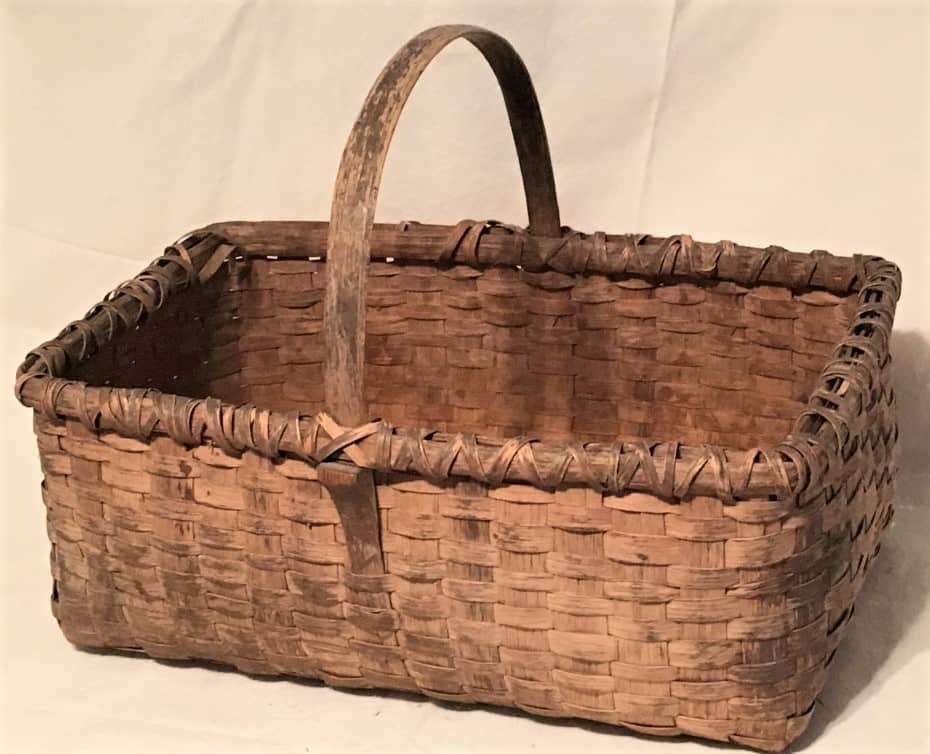Baskets
Passed down through generations and made of materials at hand, the more than forty Floyd County baskets in the Old Church Gallery collection display a diversity of construction styles and makers. John Harter, Iowa Griffith Haynes, Clovis Boyd, Charlie Hylton, and Kathy Dulaney achieved recognition in their communities as master basket makers. Others such as General McAlexander, Thomas Merritt King, and Minta Alderman Keith made baskets as needed for specific tasks on their farms.

When the three Tise sisters, Virginia, Marguerite, and Jessie Tise were very young, the family visited basket maker Iowa Griffith Haynes to select a painted basket for each. They chose these delightful, white ash baskets, sized for their ages at the time, made by Mrs. Haynes about 1920. They kept them throughout their lives.
Iowa Alice Griffith Cockram Haynes, born in Woolwine, settled in Floyd County near Haycock Mountain. She was a prolific basket maker, painting designs on her creations. These “Three Sisters” painted baskets in our collection inspired the Old Church Gallery logo. Click to browse all basket records.
Basket Types, Techniques, & Styles
Most baskets made in Floyd County fit one of two categories: Rib or Splits

Rib baskets require the most time and skill as they begin with perpendicular hoops. Basket makers whittle, smooth, and bend green wood to create the hoops which they secure with small nails or string. The upper half of the vertical hoop becomes the handle, the lower half the spine. The horizontal hoop forms the rim of the basket and is sometimes doubled for strength. Both Clovis Boyd and General McAlexander demonstrated this to potential buyers by standing on their baskets.
Long, thin splits are wrapped around the intersection of the hoops to form ears. Ribs must be shaped and inserted into the ears so that they fan out around the spine. Weaving splits continue from the ears and interlace the spaces between ribs. Depending upon the basket’s shape, additional ribs are added (equal numbers on opposite sides) as the weaving progresses.
Some Appalachian rib baskets are also known as egg baskets or buttocks baskets, such as the Thomas Merritt King lunch basket, pictured. For baskets that bulge out from the spine, some weaving splits are woven part way, then “doubled-back” over a rib instead of going rim to rim. This is less obvious on some baskets as the makers cover the spots where the weaver turns with small splices.

Some rib baskets masquerade as something different. Our crop gathering basket is actually a rib basket, although it doesn’t resemble its ribbed cousins at all.
The maker, Thomas Merritt King, began by securing an oval rim and carving two flat, central ribs to stretch the length of the basket. Shorter ribs were added on either side and splits were then interwoven from rim to rim. Replacing a separate handle, this basket has two handholds formed from open spaces left between the central ribs.

Split baskets are the simplest to make and are the most common type. They are woven from their bottoms up. The bottom splits are woven into a mat, then bent to form stakes for the sides. Thin splits are used as weavers around the sides and, depending upon whether an odd or even number of stakes is used, the weave may be continuous or the basket maker may just start each row with a different weaving split.
Basket makers create more complex patterns by varying the widths of these weaving splits or using accent splits that are dyed or rived from heartwood instead of sap wood. If a handle is desired, the basketmaker whittles one to shape with a thicker “stopper” section at each end and inserts the ends into the rows already woven just before finishing the rim. See the Arminta Alderman Keith market basket, pictured.
To finish a split basket, the stakes are trimmed, bent, and inserted back through the final rows of weaving. A separate rim may then be attached using a long thin length of split woven diagonally across each stake and around the rim. This makes the basket sturdier as well as adding visual interest.

Coiled baskets are also woven from their bottoms up. The basket maker begins by bending and coiling straw into a flat mat, then continues coiling up the sides until the basket is the desired size, as John Harter’s coiled rye-straw basket shows here. Traditionally, coils would be formed by pushing rye or winter wheat straws through a funnel-shaped piece of cow horn. New straws were then fed through the horn into the center of the coil.
The coil is first bent into a tight “U” shape and lashed together using binding made from long thin white-oak splits. Peeled blackberry or raspberry canes may also be used for binding. Basket makers sometimes use smooth flat pieces of bone as awls to spread the coils apart and insert the binding between them.
If a wooden handle is desired, it is carved by hand and attached after the coiling is completed. Wooden hoops known as feet may be attached to the bottoms of straw baskets as a base for added durability. With coiling, varying basket shapes or sizes is simple. Tightly woven straw works especially well for dough bowls because the yeast dough will not stick to the sides of the bowl as it rises.

